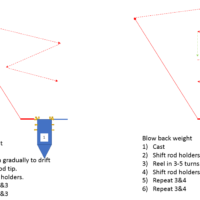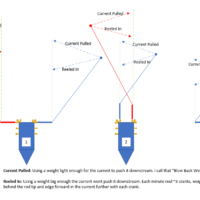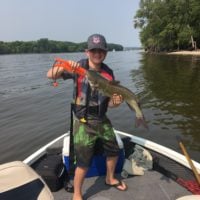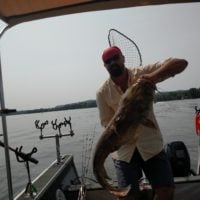This is an article for the river fisherman. Cat fisherman must read. Though written for cats, this can be a multispecies tactic. Just pick the right dunes and tackle.
Feel free to ask questions. Prefer you don’t comment If you have only skimmed the article.
One of my favorite river structures to fish is sand dunes. I just love them. Winter, Spring, Summer, Fall. Rolling drifts of sand are constantly attracting fish. These structures occur in faster sections of river where the current form drifts similar to how wind makes a snow drift. Pay attention to what creates snow drifts, where, how big, etc…as water hydraulics are very much the same. Look at the sand/grit on your curb after a good rain event, you’ll find similar structure is found in a river. Each dune provides a current break immediately downstream of the peak. 2018 Mississippi river flows this year have been high for a significant amount of time. The increased flow created bigger dunes. Long periods of low flows will start to erode the dunes. Dunes can be found with 2D sonar, DI, and SI. SI of course provides the greatest details for these broad structures, but each sonar type the dunes should stick out like a sore thumb.
I’m going to share the tactics I use to put my bait in front of the most fish possible in these dunes. Largely I believe fish will travel along these dunes. i.e. walk along the drift. As mentioned there is a current break on the back of each dune. When bottom fishing, it would be natural for your bait/weight to settle on the back side of the dune, right where a fish is travelling or resting; similar to how a bait may settle in a current seam. There can and will be fish in between dunes, on top of dunes, off the edge of dunes, etc. During certain times of the year, how fish stack up in dunes can be a clear indicator of the fish species! I will not go into that today though. Dunes come in a wide variety of shape and size. I prefer to target the largest dunes but will use side imaging to determine the best fish holding zones. Dunes are somewhat similar to waves…The bigger the wave the greater the distance between waves; the smaller the wave the less distance between waves. Think rollers vs ripples. All have their time and place to hold fish and certain species prefer certain dune conditions.
I’ve attached a picture consisting of 3 diagrams. Left to right this should be considered step 1, 2, and 3. I run multiple rod holders, and not just for running a lot of rods; I use the rod holders to move my baits. Allowing my bait to be presented in multiple locations on each cast.
I’m only showing two fishing lines in the diagram because showing you what I do when there are 6 lines out would be a scribbled drawing to say the least. On the rear of the boat I have 6 rod holders. Two are straight out the back, two are at a 45, two are straight to the side. Along each side of my boat are two more that are pointed straight out. All my rod holders get used, but primarily for rod shuffling.
Diagram 1, step 1:
Cast lines at a 45, one further than the other. Set in outside rod holder. Red rod on left, blue rod on right. If using a light enough weight (Blow Back weight) the weight will simply drift behind the rod tip on a tight line. If using a heavy weight, I encourage you to reel 1-3 cranks each minute and the weight will progress towards the rod tip with each crank. You can see the dotted arrows indicating the baits path whether you use a blow back weight or a heavy weight. Once my baits are directly behind the rod tip they aren’t going to move anymore. Thus, initiates the rod shuffle.
Diagram 2, step 2:
First rod shuffle. Take red rod and move to right side of boat. Take blue rod and more to left side of boat. You’ve just crossed lines, but because they are staggered lengths this should not cause problems if you do the right shuffling when a fish bites. By shuffling the rods, I’ve allowed the baits to drift again. When the baits are behind the rod tips, I move them again.
Diagram 3, step 3:
Move the rods further outside the boat allowing the baits to drift again. At this point I typically reel them in and re-cast duplicating the process. Often times I’ll repeat these steps and zig zag it back to the boat.
I’ve only attached a simple diagram with 2 rods and only showed 3 steps, however I will actually make this into 6 steps; touching each rod holder as the bait passes from left to right, or right to left. All various length casts. Of course, you catch fish and the program changes; I love Hi-Vis line for this tactic as you’re asking for tangles if you don’t know where your line is and how far back. Blow back weights will move easily and I may touch every rod holder from one side of the boat to the other as I drift the weight. Heaver weights I may go from one extreme to the other to accomplish the drift.
Hopefully that helps you understand the tactic.
I didn’t describe or draw all the possible ways I cast and allow baits to drift using rod holder placement, but I hope that you can understand how sand dunes allow you to drift baits and that drifting baits increases catch rates due to covering ground.
Sand dunes don’t hold many snags. Some do and expect it be a prime spot. Sand dunes allow you to drag weights and hooks without snags. As the weights drift they’ll fall into the current seams behind dunes and sit. In a single cast, it is possible for your bait to hit several dunes and in several locations. When fishing this tactic, it is common for me to LAUNCH my baits WAY out there for the outside lines and less far for each rod inside the outside ones. This prevents tangles, but also opens up lanes for crossing traffic so to speak. The more rods the bigger the spread. If I’m only running two rods I’ll start with long casts and each cast after that will be shorter to cover new ground unless there is a more active dune than another. Starting with long casts and moving to shorter casts keeps fish advancing upstream to your bait.
I have learned that if you can put a bait in front of a fish, it doesn’t take long to get a bite. In fact, when I do this tactic in the winter when the fish are not so willing to move; I’ll get bit within 30-60 seconds of moving the bait. It does you absolutely no good to keep it stationary in the winter. In the summer warm water months, fish are much more willing to move. The classic cast and wait works because fish are willing to move to find it… Flatheads, sturgeon, channel cats will all pounce on a bait within a minute, if you drop it in front of them. So, the name of the game in the dunes is covering ground! Keep them moving, canvas the area, and move on.
This is not a lazy cast and wait technique. When the fish are concentrated, like in the winter; this is a tactic that can land over 30 catfish in 3 hours, multiple doubles and triples. Fish are spread out in the summer so catch rates like that are not possible. Insert SAD face. I hoped to rival my winter catch rates this summer but have come to the conclusion that the best channel cat fishing DOES NOT OCCUR ABOVE 40 DEGREES.
I’ve also attached a diagram that shows what you can do with each line out depending on if you are using blow back weights or heavy weights. Both zig zag back to the boat. But different. Blow back weights selection is critical in the drift speed. Lighter the weight faster it will drift and further you must cast to allow for several zig zags before the weight won’t hold bottom.
Hope you learned something.
This is written for cats. Though it can be applied to tactics used to catch other species in the dunes. I used this tactic last week to entertain my two nephews 3&5 yrs old. Hammering sheepshead, catfish, perch, walleyeys, etc. I just downsized my presentation to a small weight, hook and worm; as well as picked dunes with kid sized fish.
This is honestly a subject that I could talk about for over 8 hours in the boat. You’ve got the shortened version.





